
 E-mail:
voyage@voyagehndr.com
E-mail:
voyage@voyagehndr.com

BLOG
Maximizing Efficiency with the Latest Automatic Rebar Tying Tool Technology
The construction industry is continually evolving, with advancements in technology playing a pivotal role in enhancing productivity and efficiency. One significant innovation is the Automatic Rebar Tying Tool, which has been shown to dramatically reduce labor costs and time associated with rebar installation. According to a report by the Associated General Contractors of America, labor productivity on construction sites can be improved by up to 30% through the use of automated tools. Furthermore, the global market for construction automation is expected to grow significantly, with estimates suggesting a CAGR of over 10% through the next five years, emphasizing the increasing reliance on tools like the Automatic Rebar Tying Tool. By integrating these advanced technologies, construction companies can not only improve efficiency but also ensure improved safety and precision on the job site, ultimately leading to enhanced overall project outcomes.

Benefits of Automatic Rebar Tying Tools in Construction Efficiency
Automatic rebar tying tools have revolutionized the construction industry by significantly enhancing efficiency on job sites. These innovative devices streamline the process of tying rebar, which is crucial in reinforcing concrete structures. By automating the task, workers can complete the job faster and with more consistency, dramatically reducing labor time. This efficiency not only leads to faster project completion but also decreases labor costs, allowing construction managers to allocate resources more effectively.
Moreover, the use of automatic rebar tying tools minimizes the physical strain on workers. Traditionally, tying rebar is a repetitive and physically demanding task, often leading to fatigue and injuries. With automated tools, the ergonomic benefits become evident as workers experience less stress on their hands and backs while maintaining productivity. As a result, projects can be executed with a safer working environment, ultimately enhancing overall job satisfaction and productivity in the construction field. The integration of this technology exemplifies how embracing modern tools can lead to significant improvements in construction efficiency.
Recent Innovations: How Digital Technology Enhances Rebar Tying
Recent innovations in digital technology have significantly transformed the construction industry, particularly in the realm of rebar tying. The emergence of automatic rebar tying tools equipped with advanced digital features has streamlined the tying process, increasing both speed and accuracy. These tools now utilize real-time data analytics to optimize tying patterns and reduce material waste, ultimately resulting in cost savings for construction projects.
Furthermore, integration with mobile applications allows workers to monitor and control these tools remotely, providing greater flexibility on job sites. Enhanced features such as programmable tying schedules and adjustable tension settings enable operators to customize the tying process according to specific project requirements. This leap in technology not only improves efficiency but also promotes safety by minimizing manual handling and reducing the risk of injury, making the latest automatic rebar tying tools a crucial component in modern construction practices.

Comparative Analysis: Manual vs. Automatic Rebar Tying Tool Performance
The construction industry is witnessing a significant transformation with the advent of automatic rebar tying tools. A comparative analysis of manual versus automatic tool performance indicates that automatic solutions not only enhance efficiency but also improve safety standards on job sites. Recent data has demonstrated that automatic tools can reduce labor costs by up to 30% and increase tying speed by over 50%, allowing crews to focus on more complex tasks rather than repetitive manual labor.
In light of advancements in technology, particularly in machine learning, the integration of data-driven methods is reshaping how concrete structures are constructed and maintained. Research highlights that utilizing intelligent systems can enhance durability assessments and streamline damage diagnosis processes. By leveraging predictive models, construction teams can proactively address potential issues before they escalate, further solidifying the case for adopting automatic tools. As the industry adapts to these innovations, the performance gap between manual and automatic methods continues to widen, underscoring the benefits of investing in cutting-edge rebar tying technology.
Industry Statistics: Cost Savings with Advanced Rebar Tying Solutions
Advancements in automatic rebar tying tools are transforming the construction industry, offering significant cost savings and efficiency improvements. The introduction of robotic technologies, such as automated rebar tying solutions, enables construction crews to complete tasks more swiftly and with greater precision. By reducing labor costs and minimizing the time spent on manual tying, these innovations allow projects to stay on budget and on schedule, contributing to overall cost efficiency in construction operations.

Recent industry statistics indicate that the adoption of advanced rebar tying solutions can lead to substantial savings. Projects leveraging such technology report reduced workforce requirements and minimized material wastage. As the construction sector moves towards 2025, the integration of automation in tasks like rebar tying is poised to play a pivotal role in reshaping work processes and enhancing productivity. As firms embrace these cutting-edge solutions, the potential for more streamlined operations and improved safety on job sites is increasingly evident, marking a significant evolution in construction practices.
Future Trends: The Role of Automation in Rebar Tying and Construction Safety
The landscape of construction safety is rapidly evolving, particularly with the integration of automation technologies in rebar tying processes. Recent studies, such as the report from the Construction Industry Institute, indicate that automatic rebar tying tools can improve productivity by up to 40% while significantly reducing workplace injuries. The precision of these tools minimizes human error, creating a safer environment for workers. As the industry increasingly adopts automation, the future of construction sites will likely see fewer accidents and a greater emphasis on efficiency.
Tips: Consider investing in training programs for your workforce to familiarize them with new automatic tools. Proper training not only enhances safety but also maximizes the benefits of automation in your operations.
Emerging trends highlight a shift toward smart automation, where tools can analyze their surroundings and adapt accordingly. According to a McKinsey report, companies that embrace these technologies are poised to increase their competitive edge, with automation projected to boost overall project performance metrics. By integrating advanced rebar tying solutions, construction firms are setting the stage for a safer, faster, and more efficient future.
Tips: Regular maintenance of automatic rebar tying tools is essential to ensure optimal performance and safety standards. Schedule routine checks to prevent equipment malfunctions that could compromise safety.
Maximizing Efficiency with the Latest Automatic Rebar Tying Tool Technology - Future Trends: The Role of Automation in Rebar Tying and Construction Safety
| Dimension | Value |
|---|---|
| Average Tying Speed (ties/min) | 35 |
| Operator Injury Rate (%) | 2.5 |
| Initial Investment ($) | 5,000 |
| Average Lifespan (years) | 7 |
| Reduction in Labor Costs (%) | 40 |
| Expected Efficiency Improvement (%) | 50 |
| Automated System Downtime (%) | 5 |

